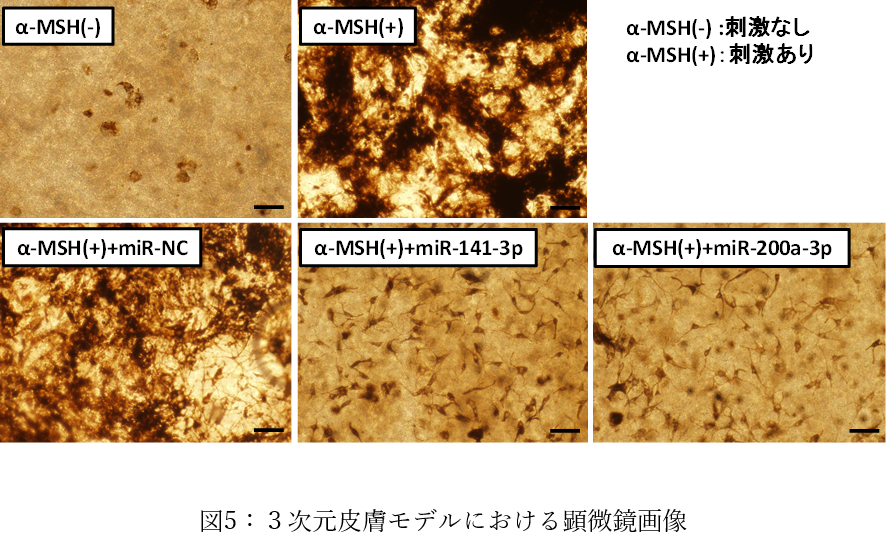Press Releases
* Please note that the news release contains the content at the time of the announcement and may differ from the latest information.
We discovered new microRNAs involved in melanin production in skin cells, suggesting that their introduction suppresses melanin production.
-Expected to be used in cosmetics development-
Euglena Co., Ltd.
National University Corporation Mie University
Euglena Co., Ltd. (Headquarters: Minato-ku, Tokyo, President: Mitsuru Izumo, hereinafter "Euglena") is an associate professor at the Graduate School of Bioresources, Mie University (Tsu City, Mie Prefecture, President: Yoshihiro Komada). Through joint research with, we discovered two types of microRNA * 2 (hereinafter referred to as "miRNA") that regulate melanin * 1 production, and research results suggesting that the introduction of these microRNAs suppresses melanin production in skin cells. confirmed. The results of this research are expected to be used in the development of cosmetics that suppress the production of melanin in skin cells.
The results of this research were published in the online academic journal "Scientific Reports" published by Nature Research on February 7, 2020 (https://nature.com/articles/s41598-020). -58911-w).
* 1 Pigment produced in organelles called melanosomes in pigment cells (melanocytes) in the basal layer of the epidermis.
* 2 MicroRNA is a type of non-coding RNA that does not encode a protein consisting of 21 to 25 bases. It has functions such as regulating gene expression, and it is said that there are more than 2,000 types in the human body.
■ Background and purpose of research
Hyperpigmentation such as skin spots is thought to be caused by excessive production of melanin in the skin due to hormonal abnormalities, ultraviolet rays, and local inflammation of the skin. In order to prevent and improve skin pigmentation, methods such as oral intake of vitamin C, which suppresses melanin production, and topical application of vitamin C, kojic acid, and hydroquinone to the skin have been used. .. On the other hand, there has been a demand for technological development that suppresses melanin production and prevents and improves pigmentation such as age spots by using miRNA that has a function of regulating the expression of target genes * 3.
This research will clarify the function of miRNA, which has the function of regulating the expression of target genes, in melanin production, and utilize it for the development of melanin production inhibitors, whitening agents, gene expression inhibitors, and cosmetics containing them. Is aimed at.
* 3 Genes involved in melanin production.
■ Research content and results
(1) We discovered miRNA involved in melanin production that occurs when irradiated with ultraviolet rays.
Mouse-derived melanocytes ※Four Melanocyte stimulating hormone (α-MSH) ※Five By stimulating with, the process of melanin production when irradiated with ultraviolet rays was reproduced. Then, when we analyzed this melanin production process, we discovered two new miRNAs (miRNA-141-3p and miRNA-200a-3p) that regulate melanin production. It was also suggested that the amount of these two miRNAs decreases intracellularly when stimulated with α-MSH.
* 4 Pigment cells that produce melanin in the basal layer of the epidermis.
* 5 A type of peptide hormone secreted from the anterior pituitary gland.


(2) When miRNA-141-3p and miRNA-200a-3p were introduced into cells, melanin production was suppressed.
Based on the fact that stimulation of melanocytes with α-MSH reduced the above-mentioned two types of miRNA, artificially prepared miRNA-141-3p and miRNA-200a-3p were introduced into cells after stimulation with α-MSH. By doing so, we confirmed whether melanin production was suppressed. As a result, it was suggested that the introduction of miRNA-141-3p and miRNA-200a-3p suppressed melanin production.

* MiR-NC: A negative control reagent designed with a unique sequence that does not target any human, mouse, or rat gene, and is used as a control during miRNA introduction tests.
* Arbutin: A hydroquinone glycoside contained in the leaves of plants such as bilberries, bearberries, and pears. It exhibits a whitening effect by inhibiting tyrosinase, which is a rate-determining enzyme for melanin production, and is approved as a quasi-drug for whitening.
(3) The introduction of miRNA-141-3p and miRNA-200a-3p suppressed melanin production even in a three-dimensional human skin model.
Using a three-dimensional human skin model that mimics human skin, we confirmed whether miRNA-141-3p and miRNA-200a-3p suppress melanin production after stimulation with α-MSH. MiRNA-141-3p and miRNA-200a-3p were introduced into the skin model using liposomes * 6, and melanin production was promoted in a medium stimulated with α-MSH. As a result, it was suggested that the production of melanin is also suppressed in the three-dimensional human skin model. This is a result that miRNA-141-3p and miRNA-200a-3p suppress the production of melanin in skin cells, and the possibility of developing cosmetics by utilizing these miRNAs is expected.
* 6 Spherical vesicles used in experiments to introduce components into cells.


<About Mie University>
Mie University is a comprehensive university founded in 1949 with the predecessors of Mie Normal School, Mie Youth Normal School and Mie Agriculture and Forestry College, and has added the Graduate School of Regional Innovation to the Faculty of Humanities, Faculty of Education, Faculty of Medicine, Faculty of Engineering, and Faculty of Bioresources. Including 5 faculties and 6 graduate schools, Liberal Arts Education Institute, Regional Human Resources Education Development Organization, Regional Innovation Promotion Organization, Regional Base Satellite, International Exchange Center, Comprehensive Information Processing Center, Student Comprehensive Support Center, International Environmental Education and Research Center, It has many on-campus joint education and research facilities such as an admission center. The basic idea is "Mie University, as a comprehensive university, can contribute to" promotion of human welfare, "" coexistence of humankind in nature, "and" development of local communities, "based on the achievements and traditions of education and research. Aiming to "cultivate and create research," we will work hard to become a base for transmitting and receiving academic culture. "http://mie-u.ac.jp/
<About Euglena Co., Ltd.>
In 2005, we succeeded in establishing the world's first edible outdoor mass culture technology for the Euglena In addition to developing and selling functional foods and cosmetics that utilize the Euglena and Chlorella produced on Ishigaki Island, we are also conducting research toward the production of biofuels. Listed on TSE Mothers in December 2012. TSE First Section market change in December 2014. The management philosophy is "to make people and the earth healthy". https://euglena.jp
-Contact for inquiries from the press-
Euglena Co., Ltd. Corporate Communication Division
Mie University Graduate School of Bioresources Office
